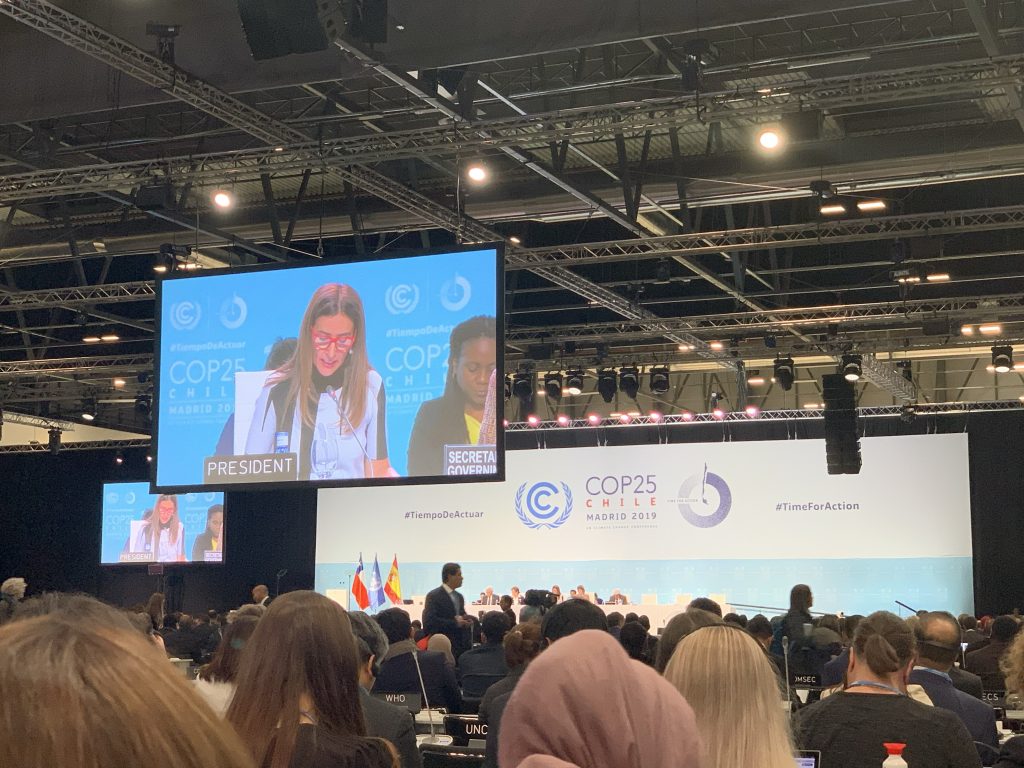
Duke delegates were inspired by these ~inspiring~ posters to hold hands to demonstrate that this is not climate change. . . this is a climate emergency
As I sit on the plane back to Durham after this whirlwind week, I realize just how much I have learned about international climate policy by attending COP25. Though I have been following the agreements coming out of the UNFCCC for several years, there is nothing like being on the ground and watching the negotiations play out to understand the myriad of interests affecting the outcomes on various issues being negotiated at the COP. As I mentioned in some of my daily reflections, I focused on one issue, Article 6 of the Paris Agreement (emissions trading and carbon markets), being negotiated as I was working with the International Emissions Trading Association (IETA) at the COP. I had a pre-existing interest in the outcome on Article 6 at this COP, but also think it was helpful in planning my activities during the week, as I could focus in on one topic.
We were warned of how overwhelming the COP was, but I could not have anticipated exactly how much goes on at one of these conferences. The number of bodies meeting under the UNFCCC is immense: after the opening COP plenary, separate meetings of the SBI, SBSTA, CMA, CMP, AWG on an incalculable number of topics, as well as coordination meetings of different coalitions such as AILAC, SIDS, African Group, EIG, COMIFAC, G77+China, LDC and numerous other categories of meetings happen every day. Talk about alphabet soup! Also, these are only official meetings pertaining to the official negotiations. In addition to negotiation meetings, there are also press conferences, official UNFCCC side events, unofficial side events happening in various pavilions in the conference centre, and surely other kinds of meetings/events that I missed out on.

COP President & Chilean Minister of Environment, Carolina Schmidt addressing the COP at the opening plenary
My work this week for IETA was to help with note-taking in negotiation sessions (a surprisingly intense task) and support a collaboration between IETA and other organizations (including Conservation International, Environmental Defense Fund, and others) who strategized together to influence the technical negotiations of Article 6. Working with this group was an invaluable experience to understand the behind-the-scenes of what goes on during these negotiations. Article 6 of the Paris Agreement deals with three main aspects of transferring international emissions reductions: (1) “cooperative approaches” which provides for the trading of emissions reductions between countries to achieve their emissions reductions goals of the Paris agreement, (2) a sustainable development mechanism which will operate similarly to the Kyoto Protocol’s mechanisms, and (3) non-market approaches to country’s emissions reductions. This year, the Parties are trying to decide on guidance for how these mechanisms should work, or the Rulebook for this new international carbon market.

The first ‘informal consultation’/negotiation session on Article 6. The room was packed and plenty of people sat on the floor or stood at the back to listen to the negotiation.
Technical issues are negotiated in the first week and political issues are negotiated in the second week. The Article 6 negotiators have a mammoth task ahead of them to decide on highly contentious and exceedingly technical and complicated issues under this Article. Because of this difficulty, last year’s talks totally collapsed, but many people felt that the Parties had a better understanding of the main disagreements to negotiate more effectively this year. The Parties met every day and I attended all sessions that were open to observers. Over the course of the week, tensions mounted as Parties expressed frustration at the procedures that seemed to hinder, rather than help, a highly complex negotiation. Some Parties were pushing for the most stringent requirements to avoid double counting of emissions reductions, no transfer of pre-2020 emissions reductions credits (those from the Clean Development Mechanism of the Kyoto Protocol) into the new market, environmental integrity of credits generated under the system, and recognition of sustainable development and human rights in the text. Other Parties had different views–that human rights should not be included in the guidelines for Article 6, that pre-2020 credits should be permitted into the new market, and that there not be overly burdensome requirements of what “sustainable development” means for the purposes of Article 6. This deadlock continued throughout the week and I will continue to follow the negotiations next week from Durham to see how Parties begin to compromise to hopefully reach an agreement that suits all Parties.

Standing in front of the UN Sustainable Development Goals which are an essential consideration when crafting international climate policy.
One of my key takeaways from this process was how (relatively) easy it is to actually influence the negotiation process from the outside if you are technical expert committed to doing so. Many Parties are not clear on what they think the rules should actually say, and all of the people I was working with were able to have direct consultations with Party delegates, sharing their advice on what that Party’s position should be on various issues during the lunch break or in between sessions. One of the position papers we drafted the morning before the second round of negotiations on a new iteration of the guidelines’ text was spotted being read by a Party delegate sitting in the negotiation room! Additionally, we heard some Parties include several points from our advice in their interventions in the negotiation. Our group was undoubtedly having an influence on the outcome of the negotiations, which is an exciting thing for me to see as I hope to venture into this policy area later in my career.
There are many more things I learned at COP25 that might be of more interest if you are not an Article 6 nerd like me. More reflections to come soon!